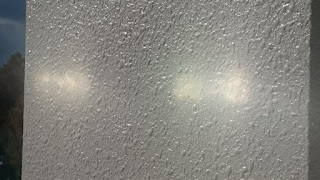For the past couple of years I've been looking at the windows at work and thinking how thick they are.
Not so much as a question, but more as an exclamation. Last year I wanted to estimate their thermal performance as an activity for a lesson on windows, so I measured the thickness of the glass, and it came to 8 mm. This was the thickness for two panes, plus glass, which leaves precious little air between, and it is the air between that is important since it is around fifty times better at insulation than the glass is. I guessed the 8 mm was made up of 2 mm panes with a 4 mm air gap, although usually glass is 3 mm, which would leave a 2 mm air gap.
 A year later, I was still in disbelief at either a 2 mm air gap, or 2 mm panes of glass, and I was still wondering how I could actually measure the thickness of panes and air gap when I remembered that glass was transparent, and its surfaces reflect light. I have no idea why I didn't think of that before. Using a spoon on a sunny day, I got these pictures, and it looks like the ratio of air thickness to glass thickness is around two to one.
A year later, I was still in disbelief at either a 2 mm air gap, or 2 mm panes of glass, and I was still wondering how I could actually measure the thickness of panes and air gap when I remembered that glass was transparent, and its surfaces reflect light. I have no idea why I didn't think of that before. Using a spoon on a sunny day, I got these pictures, and it looks like the ratio of air thickness to glass thickness is around two to one.
I used a smartphone to take these pictures since looking directly into the sun can be very dangerous, even it if is reflected by a spoon and a window.
Having found no evidence of 2 mm glass window panes, I decided to measure the thickness again, subtracting the inside and outside relief of glass to frame from the width of the frame. It was 11 or 12 mm. I measured this several times to check there was no mistake, but it was definitely not 8 mm, as I had believed for the past year. The windows are likely the industry minimum standard of 3-6-3. Three mm glass panes with a 6 mm air gap.
I have no idea why I didn't take another measurement a year ago when I came up with the highly improbable thickness of 8 mm. It is a useful reminder that everyone is wrong sometimes, and that doesn't stop us from being sure of our beliefs.
Using these values, we calculated the U value of the glass to be around 2.3 W/m2K. We also estimated the U value of the frames, which are non-thermally improved aluminium, and derive most of their benefit from the surface resistance. This means around 5.6 W/m2K.
The relative area of glazing to frame was 77:23, so the windows as a whole had a U value around 3 W/m2K. Not terribly good, and illegal in many countries, but not quite as bad as I estimated last year.
